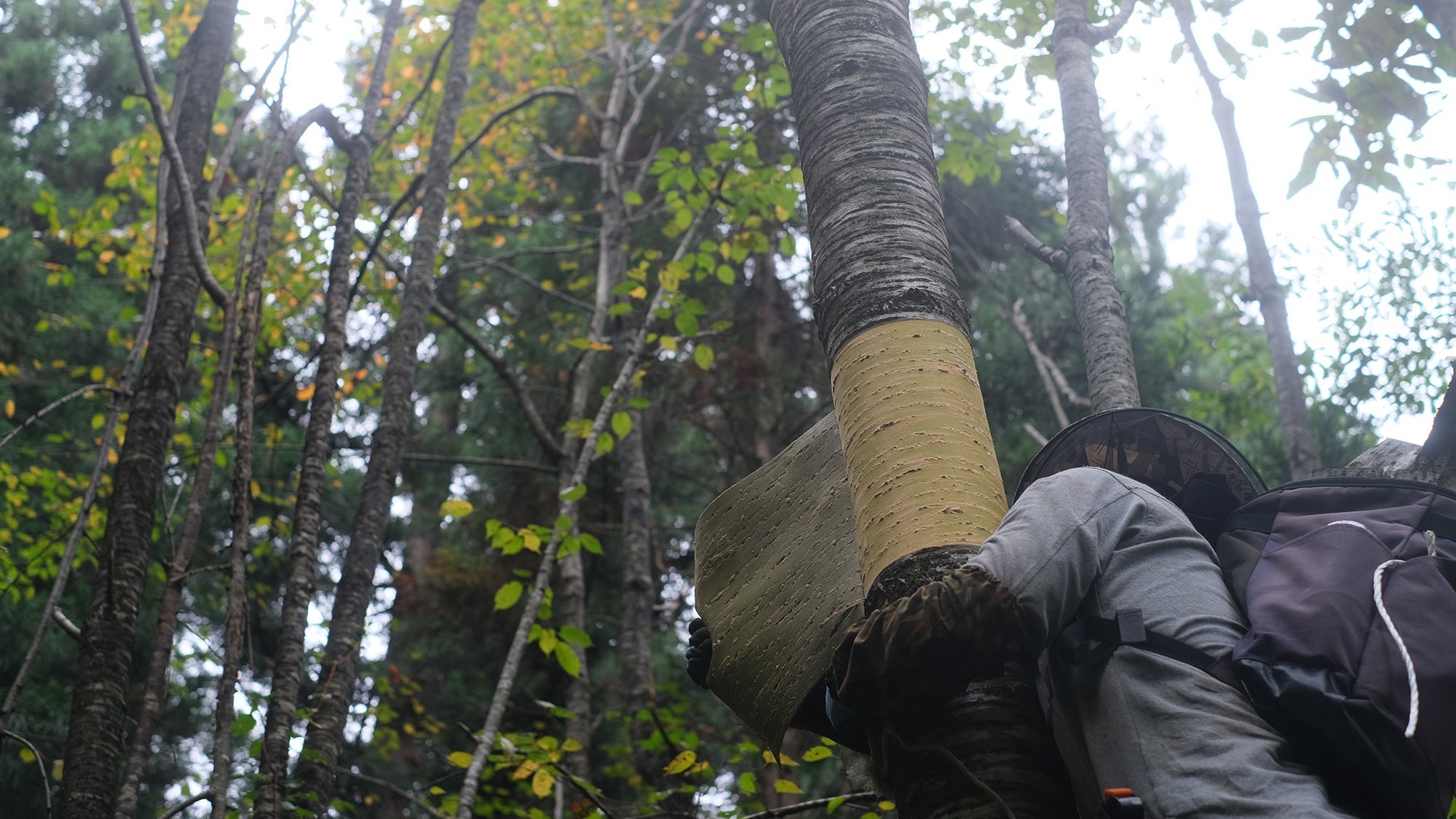
From Tree to Treasure: Cherry Bark Craft From YATSUYANAGI
Written by Team MUSUBI
As summer approached, Team Musubi traveled to Akita Prefecture in northeastern Japan to explore the world's only craft made from the bark of wild cherry trees: kabazaiku .

During the journey from Tokyo to Akita, the scenery outside the window gradually transformed from the bustling vibrancy of the metropolis to the serene nature of small towns. Continuous mountain ranges, covered by well-preserved dense forests, gave the landscape a lush, velvety appearance. We marveled at the beauty of nature and eagerly anticipated exploring this enchanting forest further.
Our destination was YATSUYANAGI, a company celebrated for its exquisite kabazaiku items. Join us on an artful journey from raw cherry bark to the finished products, witnessing a craft preserved through generations right in the heart of nature.
Our destination was YATSUYANAGI, a company celebrated for its exquisite kabazaiku items. Join us on an artful journey from raw cherry bark to the finished products, witnessing a craft preserved through generations right in the heart of nature.
Table of Contents
Kabazaiku: A Gift from Nature
Arriving at YATSUYANAGI, we received the warm welcome of the CEO Yatsuyanagi Kotaro. His family has been producing kabazaiku items for generations. He explained the entire process of this special craft, from the raw material collection and processing to product creation, giving us a comprehensive understanding of kabazaiku.

The word "kabazaiku" originates from the Manyoshu, Japan's oldest collection of poetry from the late Nara period (710 CE–794 CE). In the long poems of the Manyoshu, wild cherry trees were referred to as kaniha, which eventually evolved into kaba.
Artisans use time-honored techniques passed down through generations to harvest just the bark of wild cherry trees without causing any damage to the trees. New bark grows back after a few years, making this a sustainable process. Kabazaiku not only looks aesthetically pleasing but also has excellent properties in preventing both humidity and drying. It seems like a gift from nature, allowing us to appreciate its beauty in our daily lives.
Artisans use time-honored techniques passed down through generations to harvest just the bark of wild cherry trees without causing any damage to the trees. New bark grows back after a few years, making this a sustainable process. Kabazaiku not only looks aesthetically pleasing but also has excellent properties in preventing both humidity and drying. It seems like a gift from nature, allowing us to appreciate its beauty in our daily lives.

Challenges in Cherry Bark Collection

After learning about kabazaiku, Yatsuyanagi explained the difficulties encountered during the harvesting process. He explained that the collection typically takes place after the rainy season, as the weather begins to heat up. Workers clad in heavy protective gear to navigate the humid and stifling forest. A meticulous search from top to bottom for suitable bark is conducted.
However, success isn't always assured; it involves careful study of topographic maps and navigation through thick underbrush to locate the right trees. Even then, there are times where they return empty-handed, unable to remove the bark smoothly.
However, success isn't always assured; it involves careful study of topographic maps and navigation through thick underbrush to locate the right trees. Even then, there are times where they return empty-handed, unable to remove the bark smoothly.

Yatsuyanagi said they sometimes need to talk with nearby residents and lumber dealers to find out which mountains are scheduled for logging and negotiate with landowners for access. In some cases, the bark of soon-to-be-felled trees is not needed, allowing them to collect it.
Yatsuyanagi mentioned that on rainy days or the day after, the bark cannot be collected due to moisture causing it to curl. Additionally, bark cannot be harvested from logs that have already been felled. He also mentioned the risk of encountering bears.
Yatsuyanagi mentioned that on rainy days or the day after, the bark cannot be collected due to moisture causing it to curl. Additionally, bark cannot be harvested from logs that have already been felled. He also mentioned the risk of encountering bears.

Following his introduction and explanation, we gained a profound understanding of the various difficulties faced during the gathering of raw materials. After collection, the bark needs to undergo natural drying for two to three years before it can be used in the subsequent production process. Each kabazaiku piece must go through numerous steps and considerable time before it can enter our lives. This showcases the true charm of traditional craftsmanship.

Encountering the Beauty of Kabazaiku
We then visited YATSUYANAGI's shop together. Every item there exuded a lustrous sheen, with some pieces adorned with vibrant shell inlays using the raden technique. The natural bark patterns on each product are unique, giving every piece its personality and making it one of a kind. Next, we visited YATSUYANAGI's artisans as they crafted and decorated kabazaiku items.
Even after returning to Tokyo, whenever we see the exquisite Akita cherry bark products at hand, it feels as if we can sense the refreshing breeze from the mountains of Akita, carrying the faint scent of cherry blossoms.
Even after returning to Tokyo, whenever we see the exquisite Akita cherry bark products at hand, it feels as if we can sense the refreshing breeze from the mountains of Akita, carrying the faint scent of cherry blossoms.

In our continuing blog post , we will delve further into the crafting and decorating processes. Please look forward to more insights on YATSUYANAGI and their stunning kabazaiku creations.







Leave a comment
This site is protected by hCaptcha and the hCaptcha Privacy Policy and Terms of Service apply.